|
|
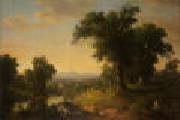 |
Asher Brown Durand
|
|
1796-1886
Asher Brown Durand Galleries
His interest shifted from engraving to oil painting around 1830 with the encouragement of his patron, Luman Reed. In 1837, he accompanied his friend Thomas Cole on a sketching expedition to Schroon Lake in the Adirondacks and soon after he began to concentrate on landscape painting. He spent summers sketching in the Catskills, Adirondacks, and the White Mountains of New Hampshire, making hundreds of drawings and oil sketches that were later incorporated into finished academy pieces which helped to define the Hudson River School.
Durand is particularly remembered for his detailed portrayals of trees, rocks, and foliage. He was an advocate for drawing directly from nature with as much realism as possible. Durand wrote, "Let [the artist] scrupulously accept whatever [nature] presents him until he shall, in a degree, have become intimate with her infinity...never let him profane her sacredness by a willful departure from truth."
Like other Hudson River School artists, Durand also believed that nature was an ineffable manifestation of God. He expressed this sentiment and his general views on art in his "Letters on Landscape Painting" in The Crayon, a mid-19th century New York art periodical. Wrote Durand, "[T]he true province of Landscape Art is the representation of the work of God in the visible creation..."
Durand is noted for his 1849 painting Kindred Spirits which shows fellow Hudson River School artist Thomas Cole and poet William Cullen Bryant in a Catskills landscape. This was painted as a tribute to Cole upon his death in 1848. The painting, donated by Bryant's daughter Julia to the New York Public Library in 1904, was sold by the library through Sotheby's at an auction in May 2005 to Alice Walton for a purported $35 million. The sale was conducted as a sealed, first bid auction, so the actual sales price is not known. At $35 million, however, it would be a record price paid for an American painting at the time. |
|
|
|
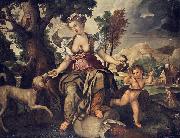 |
Augsburger Schule
|
|
painted Allegory of Remorselessness in between 1580(1580) and 1600(1600)
|
|
 |
August Strindberg
|
|
1849-1912
Swedish painter, sculptor and playwright. He had no art training, but learnt from artist friends after abandoning his studies at the University of Uppsala in 1872. The chief influence on him was Per Ekström, whose broken colour-spot technique he attempted to copy during his initial painting period in 1872-4 in Stockholm and on the skerry-islands Kymmendö and Sandhamn. Very little of Strindberg's early painting survives, but he had already found his special motifs: the sea, usually with turbulent waves; solitary trees or flowers on bare cliffs or sandy beaches in the outermost fringe of the skerries. After he stopped painting in 1874 he became Sweden's leading art critic, as well as the ideological leader of the radical Swedish artists' movement, which in 1884 formed the Konstnärsförbund (the Artists' Association) in protest against the Academy of Art. Prominent among the members were the painters Carl Olof Larsson, Karl Nordström and Richard Bergh. During this period, however, he produced sketches in words and pictures as illustrations to his own writings, which Carl Larsson was commissioned to do thereafter. From 1883 he stayed abroad, primarily in France and Switzerland, and belonged during a couple of long periods to the Scandinavian artists' colony in Grez-sur-Loing, near Fontainebleau in France. In 1886 in Switzerland he started photography and took a series of self-portraits that were intended for publication |
|
 |
Augustus Saint-Gaudens
|
|
Irish-born American Realist Sculptor, 1848-1907, He was the Irish-born American sculptor of the Beaux-Arts generation who most embodied the ideals of the "American Renaissance." Raised in New York City, he traveled to Europe for further training and artistic study, and then returned to major critical success in the design of monuments commemorating heroes of the American Civil War, many of which still stand. In addition to his famous works such as the Robert Gould Shaw Memorial on Boston Common and the outstanding grand equestrian monuments to Civil War generals John A. Logan, atop a tumulus in Chicago, 1894-97 |
|
|
|
|
|
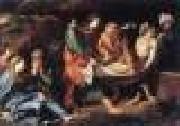 |
BADALOCCHIO, Sisto
|
|
Italian Baroque Era Painter, 1585-ca.1619
Italian painter and etcher. His formation as an artist took place within the Carracci circle. According to Malvasia, he may have attended the Carracci Academy in Bologna, before returning to Parma in 1600 as the pupil of Agostino Carracci when the latter entered the service of Ranuccio I Farnese, 4th Duke of Parma. After Agostino's death in 1602, Badalocchio and his fellow pupil Giovanni Lanfranco were sent by the Duke to Rome in order to complete their training in the studio of Annibale Carracci, who was then working in the Palazzo Farnese. Badalocchio remained with Annibale until the latter's death in 1609. He participated in most of the projects that occupied the studio assistants during those years, such as the frescoes on the walls of the Galleria in the Palazzo Farnese and those previously in the Herrera Chapel in S Maria di Monserrato, Rome (now detached and divided between Madrid, Prado, and Barcelona, Mus. A. Catalunya), although his precise share in them is still debated. His first signed works are etchings, one (1606) after the antique sculpture of the Laokoon (Rome, Vatican, Mus. Pio-Clementino) and 23 (1607, part of a series of 54 executed in collaboration with Lanfranco) after Raphael's frescoes in the Vatican Logge; they reveal the romanizing character of his training. Yet his independent paintings of this early period reveal the influence of Lanfranco, which was to last throughout his career; the lively play of light and shade suggests his allegiance to Emilian art.
|
|
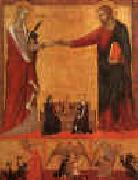 |
Barna da Siena
|
|
Italian Painter, active ca.1350
Barna da Siena, also known as Barna di Siena, was a Sienese painter active from about 1330 to 1350, and was the painter in Siena during this period. He learned his trade from Simone Martini. Barna is believed to have paint the frescoes depicting the life of Jesus in the Collegiata di San Gimignano and is generally credited with Christ Bearing the Cross, with a Dominican Friar in the Frick Collection in New York City. He was killed in a fall from the scaffolding. Barna's figures are more dramatic and vigorous than any in previous Sienese painting. |
|
|
|
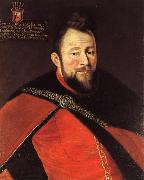 |
Bartholomaus Strobel
|
|
(Breslau 1591-1647 Thorn) was a German baroque painter from Silesia who worked in Poland.
He studied art in the studio of his father. He spent time in Vienna and in Prague. In 1633 he settled in Gdansk and in 1637 operated in Elbing, and thereafter in Torun.
According to Houbraken he received the Dutch painter Gillis Schagen in Elbing in 1637. Strobel was court painter to the emperor at that time, and later became court painter to Władysław IV Vasa, King of Poland.Schagen painted a portrait of the King of Poland to "prove his mastership of the art" for him.
According to the RKD he worked mostly in Prague.
He produced royal court paintings and paintings for the chapel of St.. Kaźmirza in Vilna, (1636-37), and religious paintings in Torue in 1634.
|
|
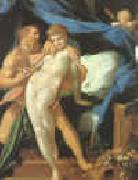 |
Bartholomeus Spranger
|
|
1546-1611
Flemish
Bartholomeus Spranger Gallery
Bartholomeus (Bartholomaeus) Spranger (21 March 1546??August 1611) was a Flemish Mannerist painter, draughtsman, and etcher. He was born in Antwerp.
In 1565, he traveled to Paris and Italy after finishing his studies. He worked on wall paintings in various churches. At Rome, Pope Pius V appointed him court painter in 1570. In 1581 he was appointed to the Prague court of Rudolf II, Holy Roman Emperor.
Hendrik Goltzius made engravings of his paintings, thus increasing Spranger's fame. Spranger's Mannerist paintings depict nudes in various complex poses.
He died in Prague. |
|
|
|
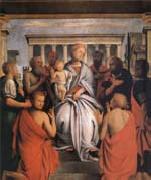 |
Bartolomeo Suardi
|
|
c. 1465?C1530,was an Italian painter and architect, mainly active in his native Milan. He was born in Milan, the son of Alberto Suardi, but his biography remains unclear, and was long complicated by two "Pseudo-Bramantinos". He was trained by Donato Bramante, adopting a diminutive form of his master's name. This training gave him influences from by the Urbino quattrocento tradition of immobile realism, and later he assimilated some elements of the style of Leonardo, after he arrived in Milan, although in other respects he remained faithful to his training in the style of Central Italy. He is documented in late 1508 as helping in the decoration of the Vatican Stanze though nothing remains of his work there, and by 1509 he was back in Milan. His style changed considerably during his career, and also shows strongly individual traits. His main influences were the serene and sometimes unnatural quietist classicism of Piero della Francesca, Leonardo da Vinci, and Ercole de' Roberti |
|
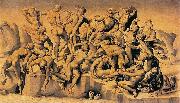 |
Bastiano da Sangallo
|
|
(1481 - May 31, 1551) was an Italian sculptor and painter of the Renaissance period, active mainly in Tuscany. He was a nephew of Giuliano da Sangallo and Antonio da Sangallo the Elder. He is usually known as Aristotile, a nickname he received from his air of sententious gravity. He was at first a pupil of Perugino, but afterwards became a follower of Michelangelo. Mentioned by Vasari as one who made a small copy of the Cartoon of Michelangelo Battle of Cascina (1506).
|
|
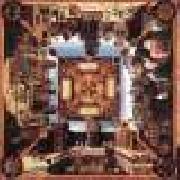 |
BEHAM, Hans Sebald
|
|
German Northern Renaissance Engraver, 1500-1550
Hans Sebald Beham (1500 ?C 1550) was a German printmaker who did his best work as an engraver, and was also a designer of woodcuts and a painter and miniaturist. He is one of the most important of the "Little Masters", the group of German artists making old master prints in the generation after Durer.
Beham is best known as a prolific printmaker, producing approximately 252 engravings, 18 etchings and 1500 woodcuts, including woodcut book illustrations. He worked extensively on tiny, highly detailed, engravings, many as small as postage stamps, placing him in the German printmaking school known as the "Little Masters" from the size of their prints. These works he produced and published himself, whilst his much larger woodcuts were mostly commissioned work. The engravings found a ready market among German bourgeois collectors, but were not much seen in Italy. He also made prints for use as playing cards, wallpaper, coats of arms, and designs for other artists, including many designs for stained or painted glass. He also illuminated two prayer books and painted a table top (now in the Louvre ) for Cardinal Albrecht, Archbishop of Mainz. |
|
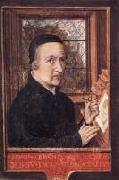 |
BENING, Simon
|
|
Flemish Northern Renaissance Manuscript Illuminator, ca.1483-1561
Simon Bening (1483?C1561) was a 16th century miniature painter of the Ghent-Bruges school, the last major artist of the Netherlandish tradition.
Bening was trained in his father Alexander Bening's miniature painting workshop in Ghent. He made his own name after moving to Bruges. His specialty was the book of hours, but by his time these were becoming relatively unfashionable, and only produced for royalty and the very rich. He also created genealogical tables and portable altarpieces on parchment. Many of his finest works are Labours of the Months for Books of Hours which are largely small scale landscapes, at that time a nascent genre of painting. In other respects his style is relatively little developed beyond that of the years before his birth, but his landscapes serve as a link between the 15th century illuminators and Peter Brueghel. His self-portrait and other portraits equally are early examples of the portrait miniature. He served as dean of the calligraphers, booksellers, illuminators, and bookbinders in the Guild of Saint John and Saint Luke.
He created books for German rulers, like Cardinal Albrecht of Brandenburg, and royalty like Emperor Charles V and Don Fernando, the Infante of Portugal.
The artistic tradition continued in his family. His eldest daughter, Levina Teerlinc, became a miniature painter, mostly of portrait miniatures and another daughter became a dealer in paintings, miniatures, parchment, and silk. |
|
|
|
|
|
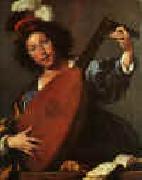 |
Bernardo Strozzi
|
|
1581-1644
Italian
Bernardo Strozzi Galleries
Strozzi was born in Genoa. He was probably not related to the other Strozzi family.
In 1598, at the age of 17, he joined a Capuchin monastery, a reform branch of the Franciscan order. When his father died c1608, he left the order to care for his mother, earning their living with his paintings, which were often influenced by Franciscan teachings, for example his Adoration of the Shepherds (c. 1615) . In 1625, he was charged with illegally practicing as a painter. When his mother died c1630, Bernardo was pressured in court by the Capuchin's to re-enter the order. He was briefly imprisoned in Genoa , and upon release fled to Venice to avoid confinement in a monastery in 1631. He became nicknamed all his life as il prete Genovese (the Genoa priest).
Saint Christopher, by Strozzi.Early paintings, such as The Ecstasy of St Francis show the dark emotionalism of Caravaggio. But by the second decade of the 17th century, while working in Venice, Strozzi had synthesized a personal style which fused painterly influences of the North (including Rubens and Veronese) with a monumental realistic starkness. For example, in the painting The Incredulity of Thomas, the background is muted, yet Jesus' face, haloed and his outline, misty, in a style atypical of Caravaggio. Never as dark as the Caravaggisti, Venice infused his painting with a gentler edge, a style more acceptable to the local patronage, and one derived from his precursors in Venice, Jan Lys (died 1629) and Domenico Fetti (died 1626), who had also fused the influence of Caravaggio into Venetian art. Examples of this style can be found in his Parable of the Wedding Guests (1630),Christ giving keys of Heaven to Saint Peter (1630),, Saint Lawrence distributing Alms at San Nicol?? da Tolentino[7] and a Personification of Fame (1635-6). He was also likely influenced by Velazquez (who visited Genoa in 1629-30).
After a commission to paint Claudio Monteverdi his fame grew, and his portrait paintings included many of the leading Venetians. His pupils and painter strongly influenced by him included Giovanni Andrea de Ferrari (1598-1669), Giovanni Bernardo Carbone, Valerio Castello and, Giovanni Benedetto Castiglione. |
|
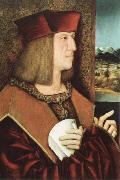 |
bernhard strigel
|
|
Bernhard Strigel (c. 1461 ?C 1528) was a German portrait and historical painter of the Swabian school, the most important of a family of artists established at Memmingen. He was born at Memmingen and was probably a pupil of Zeitblom at Ulm. He stood in high favor with the Emperor Maximilian I, in whose service he repeatedly journeyed to Augsburg, Innsbruck, and Vienna. |
|
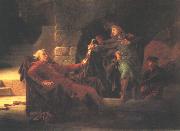 |
Bertalan Szekely
|
|
(May 8, 1835 - August 21, 1910) was a Hungarian Romantic painter of historical themes. "The Discovery of Louis II's Dead Body", "Women of Eger", "Battle of Mohe - s", "Ladislas V" are among the most important of his historical paintings. Szekely is also known for his many murals.
|
|
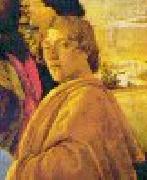 |
BOTTICELLI, Sandro
|
|
Italian Early Renaissance Painter, 1445-1510
Alessandro di Mariano di Vanni Filipepi, better known as Sandro Botticelli or Il Botticello ("The Little Barrel"; March 1, 1445 ?C May 17, 1510) was an Italian painter of the Florentine school during the Early Renaissance (Quattrocento). Less than a hundred years later, this movement, under the patronage of Lorenzo de' Medici, was characterized by Giorgio Vasari as a "golden age", a thought, suitably enough, he expressed at the head of his Vita of Botticelli. His posthumous reputation suffered until the late 19th century; since then his work has been seen to represent the linear grace of Early Renaissance painting, and The Birth of Venus and Primavera rank now among the most familiar masterpieces of Florentine art.
Details of Botticelli's life are sparse, but we know that he became an apprentice when he was about fourteen years old, which would indicate that he received a fuller education than did other Renaissance artists. Vasari reported that he was initially trained as a goldsmith by his brother Antonio. Probably by 1462 he was apprenticed to Fra Filippo Lippi; many of his early works have been attributed to the elder master, and attributions continue to be uncertain. Influenced also by the monumentality of Masaccio's painting, it was from Lippi that Botticelli learned a more intimate and detailed manner. As recently discovered, during this time, Botticelli could have traveled to Hungary, participating in the creation of a fresco in Esztergom, ordered in the workshop of Fra Filippo Lippi by Vitez J??nos, then archbishop of Hungary.
By 1470 Botticelli had his own workshop. Even at this early date his work was characterized by a conception of the figure as if seen in low relief, drawn with clear contours, and minimizing strong contrasts of light and shadow which would indicate fully modeled forms. |
|
 |
Bourdon, Sebastien
|
|
French, 1616-1671.French painter. Bourdon was active in Rome (1634 C37), in Sweden (1652 C54) as Queen Christina's court portrait painter, and in Paris; he also worked in his native Montpellier, where he painted The Fall of Simon Magus for the cathedral. The Finding of Moses is in the National Gallery of Art, Washington, D.C. |
|
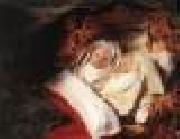 |
BRAY, Salomon de
|
|
Dutch Baroque Era Painter, 1597-1664
De Bray established himself in Haarlem before 1617, where he is supposed to have been taught by Hendrick Goltzius and Cornelis van Haarlem, and where he married in 1625. He painted history paintings, portraits and landscapes. As a Catholic he probably also made altar pieces for clandestine churches. He cooperated in the decoration of Huis ten Bosch in The Hague. His works draw on the spirit of the Dutch classicism beginning at that time, and are comparable with those of Pieter de Grebber.
De Bray was also active as a designer of silverwork, as a poet, as an architect and as a town planner. As an architect, he was involved in the construction or expansion of Haarlem's City Hall, Zijlpoort, and St. Annakerk (Church of St. Anne), and Nijmegen's city orphanage. One of his poems was set to music by his friend the composer Cornelis Padbru??.
Salomon de Bray was the father of ten children, of whom three (including Jan de Bray) became artists. He probably died of the plague, as some of his children and was buried in the Sint-Bavokerk in Haarlem. |
|
 |
Burne-Jones, Sir Edward Coley
|
|
British Pre-Raphaelite Painter, 1833-1898
English painter and decorative artist. He was the leading figure in the second phase of the Pre-Raphaelite movement. His paintings of subjects from medieval legend and Classical mythology and his designs for stained glass, tapestry and many other media played an important part in the Aesthetic Movement and the history of international Symbolism. |
|
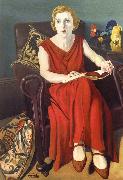 |
Cagnaccio di San Pietro
|
|
Italian, 1897-1946,born Natale Bentivoglio Scarpa, was an Italian magic realist painter. He had his artistic training at the Academy of Fine Art in Venice, where he studied under Ettore Tito. Cagnaccio's early paintings were in a Futurist idiom, but by the early 1920s he had adopted a very smoothly brushed, nearly photographic style. His work, which includes portraits, nudes, still lifes, scenes of popular life, and religious pictures, shows the influence of the German painters of the New Objectivity. One of his best-known paintings, After the Orgy (1928) shows three nude women asleep on a floor littered with wine bottles, playing cards and cigarettes. |
|
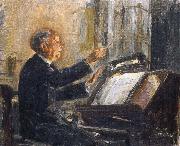 |
camille saint
|
|
Period: Post-Romantic (1870-1909)
Country: France
Born: October 09, 1835 in Paris, France
Died: December 16, 1921 in Algiers, Algeria
Genres: Chamber Music, Choral Music, Concerto, Keyboard Music, Miscellaneous Music, Opera, Orchestral Music, Symphony
|
|
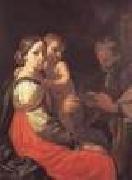 |
CANTARINI, Simone
|
|
Italian painter, Bolognese school (b. 1612, Pesaro, d. 1648, Pesaro)
Simone Cantarini (also known as Simone da Pesaro; 12 April 1612 - 1648) was an Italian painter and etcher of the Bolognese School of painting.
Cantarini was born in Oropezza near Pesaro, then part of the Papal States.
Initially he was a pupil of the Venetian Claudio Ridolfi and Pesarese Giovanni Giacomo Pandolfi, and then, for about 4 years (1635-1639), of Guido Reni. He soon fought with his mentor, and did not return to Bologna till after Reni had died (1642). His pictures are generally derivative. Some of his works have been mistaken for examples of Reni. Among his principal paintings are St. Anthony, at Cagli; the Magdalene, at Pesaro; the Transfiguration in the Brera Gallery, Milan; the Portrait of Guido, in the Bologna gallery; and St. Romuald, in the Casa Paolucci. His most celebrated etching is Jupiter, Neptune and Pluto, honoring the heraldic arms of Cardinal Borghese. |
|
|
|
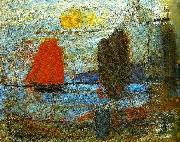 |
carl kylberg
|
|
Carl Oscar Kylberg, född 23 september 1878 på Vasängen i Fridene församling, död 6 januari 1952 i Stockholm, svensk konstnär och representant för Göteborgskoloristerna.
Carl Kylberg var son till kontorschef Gustaf Kylberg och friherrinnan Eleonora von Essen och storebror till konstnären Erik Kylberg. Hans fastrar och farbror var konstnärerna Regina Kylberg-Bobeck, Marina Kylberg och Hjalmar Kylberg. Farfadern Lars Wilhelm Kylberg var konstnär vid sidan av lantbruket på familjegodset Såtenäs i Västergötland.
Kylberg studerade först vid tekniska skolan i Stockholm och i Berlin för att bli arkitekt men övergick till måleri omkring 1900. Han studerade under en tid vid Valand i Göteborg som elev till Carl Wilhelmson. Hans verk kännetecknas ofta av ett glödande oljemåleri med starka färger och han avbildade ofta landskap och figurkompositioner på ett avskalat man??r. Under senare delen av sitt konstnärskap skapade han en mängd religiösa motiv.
Kring 1930-talet fick han sitt genombrott och han kom att ställa ut, förutom i Sverige även i Köpenhamn, Paris, London, Budapest och i USA men hans måleri var för många provocerande och 1938 gick regeringen in och stoppade ett köp av målningen Uppbrottet för Nationalmuseum i Stockholm.
En av hans mest välkända målningar är Hemkomsten från 1938 som hänger på Göteborgs konstmuseum och som föreställer ett skepp i silhuett mot en nästan brinnande gul himmel och ett rödfärgat hav. Denna målning förevigades också 1978 på ett svenskt frimärke av valören 90 öre.
Sedan 1980-talet har många av hans tavlor sålts för rekordpriser vid olika internationella konstauktioner.
|
|
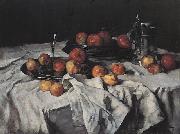 |
Carl Schuch
|
|
(30 September 1846 - 13 September 1903) was an Austrian painter, born in Vienna, who spent most of his lifetime outside Austria, in Germany, Italy and France. He painted primarily still lifes and landscapes.
During the period 1882-94 he was based in Paris, where he was greatly impressed by the work of Claude Monet whom he described as "the Rembrandt of plein-air painting" although he was attracted most of all to Rembrandt and the artists of the Barbizon school. In 1884 and 1885 he spent the summer months in the Netherlands, studying the Dutch old masters as well as the contemporary painters of the Hague School, and filling notebooks with detailed descriptions of the colors he observed in paintings that he admired. Of all the artists belonging to the circle around Wilhelm Leibl (called the Leibl-Kreis), Schuch was the most devoted to color. His work marks the transition from the realist tradition to the modern movement in Vienna, esthetically, however, it is far from contemporary trends, and from its means and ends, comparable to Paul Cezanne (Gottfried Boehm, referring to Arnold Gehlen). |
|
|
|
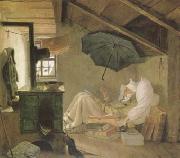 |
Carl Spitzweg
|
|
German Painter, 1808-1885
German painter. He trained (1825-8), at his father's insistence, as a pharmacist, by 1829 becoming manager of a pharmacy in the Straubing district of Munich. From 1830 to 1832 he made advanced studies in pharmacy, botany and chemistry at the University of Munich, passing his final examination with distinction. On receiving a large legacy in 1833, which made him financially independent, he decided to become a painter. He had drawn since the age of 15 and had frequented artistic circles since the late 1820s; but he had no professional training as a painter. He learnt much from contacts with young Munich landscape painters such as Eduard Schleich the elder and produced his first oil paintings in 1834. In 1835 he became a member of the Munich Kunstverein but left two years later due to disappointment over the reception of the first version of the Poor Poet (1837; Munich, Neue Pin.; second version 1839; Berlin, Neue N.G.), a scene of gently humorous pathos that has since become his most celebrated work. Spitzweg's decision to leave the Kunstverein, however, was also encouraged by his first successful attempts to sell his paintings independently. In 1839 he travelled to Dalmatia, where he made sketches that he used for many later works on Turkish themes (e.g. the Turkish Coffee House, c. 1860; Munich, Schack-Gal.). From the 1840s he travelled regularly, usually with his close friend, the painter Schleich, both within Bavaria and to Austria and Switzerland and also to the Adriatic coast, especially to Trieste. |
|
|
|
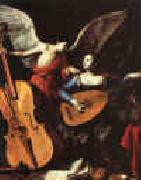 |
Carlo Saraceni
|
|
1580-1620
Italian
Carlo Saraceni Galleries
Carlo Saraceni (Venice 1579-Venice, 16 June 1620) was an Italian early-Baroque painter, whose reputation as a "first-class painter of the second rank" was improved with the publication of a modern monograph in 1968.
Though he was born in Venice, his paintings are distinctly Roman in style; he moved to Rome in 1598, joining the Accademia di San Luca in 1607. He never visited France, though he spoke fluent French and had French followers and a French wardrobe. His painting, however, was influenced at first by the densely forested, luxuriantly enveloping landscape settings for human figures of Adam Elsheimer, a German painter resident in Rome; "there are few landscapes by Saraceni which have not been attributed to Elsheimer," Malcolm Waddingham observed, and Anna Ottani Cavina has suggested the influences may have travelled both ways. and Elsheimer's small cabinet paintings on copper offered a format that Saraceni employed in six landscape panels illustrating The Flight of Icarus; in Moses and the Daughters of Jethro and Mars and Venus.
Saint Sebastian
Castle Museum, PragueWhen Caravaggio's notorious Death of the Virgin was rejected in 1606 as an altarpiece suitable for a chapel of Santa Maria della Scala, it was Saraceni who provided the acceptable substitute, which remains in situ, the only securely dated painting of his first decade in Rome. He was influenced by Caravaggio's dramatic lighting, monumental figures, naturalistic detail, and momentary action (illustration, right), so that he is numbered among the first of the "tenebrists" or "Caravaggisti". Examples of this style can be seen in the candlelit Judith and the Head of Holofernes.
Saraceni's matured rapidly between 1606 and 1610, and the next decade gave way to his fully mature works, synthesizing Caravaggio and the Venetians. In 1616?C17 he collaborated on the frescoes for the Sala Regia of the Palazzo del Quirinale. In 1618 he received payment for two paintings in the church of Santa Maria dell'Anima. The compositional details of his fresco of The Birth of the Virgin in the Chapel of the Annunciation of the church of Santa Maria in Aquiro are repeated in a panel on copper at the Louvre
In 1620 he returned to Venice, where he died in the same year. He was so influential on the style of an anonymous still life painter working in Rome, that the man is known as "Pensionante del Saraceni" |
|
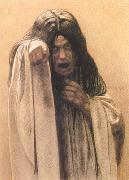 |
Carlos Schwabe
|
|
German Symbolist Painter, 1877-1926
Swiss painter and printmaker of German birth. He became a Swiss citizen and received his artistic training under Joseph Mittey (b 1853) at the Ecole des Arts Decoratifs in Geneva. Following brief success there, Schwabe moved to Paris where he supported himself as a designer of wallpaper while he developed considerable graphic skills. He soon became active in Symbolist circles, winning favour as an illustrator of mystical religious themes. His highly refined drawings and watercolours accompany texts such as Le Reve by Emile Zola (published 1892; drawings, Paris, Pompidou; exhibited Sociot Nationale des Beaux-Arts, also in 1892), Baudelaire's Les Fleurs du mal (1900), Maeterlinck's Pellias et Melisande, Catulle Mendes's L'Evangile de l'enfance de notre Seigneur Jesus-Christ selon Saint Pierre (1900) and Albert Samain's Jardin de l'Infante (1908). |
|
|
|
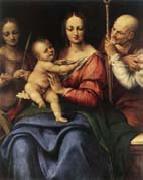 |
Cesare da Sesto
|
|
Italian High Renaissance Painter, 1477-1523, He was an Italian painter of the Renaissance active in Milan and elsewhere in Italy. He was born in Sesto Calende, Lombardy. He is considered one of the Leonardeschi or artists influenced by Leonardo da Vinci, such as Bernardino Luini and Marco D'Oggione. He may have trained or worked with Baldassare Peruzzi in Rome in 1505. Of this period, a lunette in Sant'Onofrio and some paintings in Campagnano Romano are attributed to him. From 1514 he soujourned in Naples for six years. In 1515 he finished a monumental polyptych for the Abbey of Santissima Trinita at Cava de' Tirreni. Back in Milan, he executed a Baptism of Christ, in collaboration with Bernardino Bernazzano (now lost) and a Salome, acquired by Rudolf II and now at the Kunsthistorisches Museum of Vienna. |
|
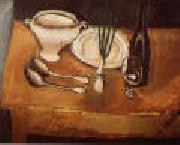 |
Chaim Soutine
|
|
Chaim Soutine Art Locations
Lithuanian 1893-1943
Soutine was born in Smilavichy near Minsk, Belarus (then part of the Russian Empire). He was the tenth of eleven children.
From 1910?C1913 he studied in Vilnius at the Vilna Academy of Fine Arts. In 1913, with his friends Pinchus Kremegne and Michel Kikoine, he emigrated to Paris, where he studied at the Ecole des Beaux-Arts under Fernand Cormon. He soon developed a highly personal vision and painting technique.
For a time, he and his friends lived at La Ruche, a residence for struggling artists in Montparnasse, where he became friends with Amedeo Modigliani. Modigliani painted Soutine's portrait several times, most famously in 1917, on a door of an apartment belonging to Leopold Zborowski, who was their art dealer. Zoborowski supported Soutine through the World War I, taking the struggling artist with him to Nice to escape the German bombing of Paris.
In 1923, the American collector Albert C. Barnes visited his studio and immediately bought sixty of Soutine's paintings.
Soutine once horrified his neighbours by keeping an animal carcass in his studio so that he could paint it (Carcass of Beef). The stench drove them to send for the police, whom Soutine promptly lectured on the relative importance of art over hygiene. In February 2006 this painting sold for £7.8 million to an anonymous buyer in London.
Soutine produced the majority of his works from 1920 to 1929. He seldom showed his works, but he did take part in the exhibition of Independent Art held in 1937 in Paris, where he was at last hailed as a great painter. Soon thereafter France was invaded by German troops. As a Jew, Soutine had to escape from the French capital and hide in order to avoid arrest by the Gestapo. He moved from one place to another and was sometimes forced to seek shelter in forests, sleeping outdoors. Suffering from a stomach ulcer and bleeding badly, he left a safe hiding place for Paris in order to undergo emergency surgery, which failed to save his life. On August 9, 1943, Chaim Soutine died of a perforated ulcer. Soutine was interred in Cimeti??re du Montparnasse, Paris. |
|
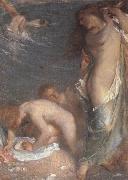 |
Charles Hazelwood Shannon
|
|
English painter, printmaker and collector , 1863-1937
English artist, was born at Sleaford in Lincolnshire, the son of the Rev. Frederic Shannon. He attended the City and Guilds of London Art School (then known as South London School of Technical Art, formerly Lambeth School of Art), and was subsequently considerably influenced by his lifetime partner Charles Ricketts[2] and by the example of the great Venetians. In his early work he was addicted to a heavy low tone, which he abandoned subsequently for dearer and more transparent colour. He achieved great success with his portraits and his Giorgionesque figure compositions, which are marked by a classic sense of style, and with his etchings and lithographic designs. The Dublin Municipal Gallery owns his circular composition "The Bunch of Grapes" and "The Lady with the Green Fan" (portrait of Mrs Hacon). His "Study in Grey" is at the Munich Gallery, a "Portrait of Mr Staats Forbes" at Bremen, and a "Souvenir of Van Dyck" at Melbourne. One of his most remarkable pictures is "The Toilet of Venus" in the collection of Lord Northcliffe. Several of his portrait works are on display in the National Portrait Gallery in London. Complete sets of his lithographs and etchings have been acquired by the British Museum and the Berlin and Dresden print rooms. He was awarded a first-class gold medal at Munich in 1895 and a first-class silver medal in Paris in 1900. |
|
|
|
 |
Charles Roscoe Savage
|
|
1832-1909, He was a British-born landscape and portrait photographer who produced images of the American West. He is best known for his 1869 photographs of the linking of the first transcontinental railroad. Savage was born in Southampton, England, on August 16, 1832. At age 14, he joined The Church of Jesus Christ of Latter-day Saints (LDS Church). After serving missions for the church in Switzerland and England, he emigrated to the United States during the winter of 1855?C56. He initially found work as a photographer in New York City, and headed west the following year. He first settled in Nebraska, then Council Bluffs, Iowa, where he established his first independent studio and gallery. In the spring of 1860, he traveled to Salt Lake City, Utah Territory with his family, where he established a photography studio with a partner, Marsena Cannon, an early Utah daguerreotypist and photographer. A year later, after Cannon moved to southern Utah, Savage established a partnership with artist George Ottinger. Many of Savage's photographs were reproduced in Harper's Weekly newspaper, which created a national reputation for the firm. This partnership continued until 1870. As a photographer under contract with the Union Pacific Railroad, Savage traveled to California in 1866 and then followed the rails back to Utah. He photographed the linking of the Union Pacific and Central Pacific on Promontory Summit, at Promontory, Utah in 1869 |
|
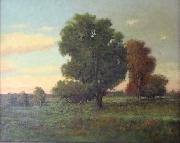 |
Charles S. Dorion
|
|
Charles was most likely born in Quebec, Canada, and moved to New York City sometime after 1880. He had a publishing company called C.S. Dorion, and was the 8th company to publish Edgar Allan Poe's the Raven, in New York in 1881.
PoliticsDuring the 1890s, Charles Dorian socialized with New York City's Social Democratic Party's elite, and used his quick tongue and self appointed crusading against injustice to help propel his friends political careers.
His first noted case was in the summer of 1893, when bucket shops were becoming a rampant problem in the city, as these "bucket shops" specializing in stocks and commodity futures, as the terms of trade were different for each bucket shop. |
|
|
|
|
|
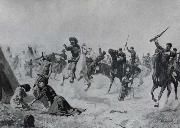 |
Charles Schreyvogel
|
|
American Painter, 1861-1912,was a painter of Western subject matter in the days of the disappearing frontier. Schreyvogel was especially interested in military life. He spent most of his life as an impoverished artist. He suddenly became recognized and earned what seemed like overnight fame. He was born in New York City. He also spent much of his childhood in Hoboken, New Jersey. He grew up in a poor family of German immigrant shopkeepers on the Lower East Side of New York. Schreyvogel was unable to afford art classes and he taught himself to draw. In 1901, he was awarded the Thomas Clarke Prize at the annual exhibition of the National Academy of Design. Schreyvogel did much of his work in his studio (or its rooftop) in decidedly non-Western Hoboken. |
|
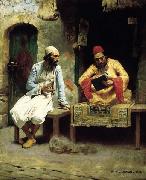 |
Charles Sprague Pearce
|
|
For other people named Charles Pearce, see Charles Pearce (disambiguation).
Charles Sprague Pearce (October 13, 1851 - May 18, 1914) was an American artist.
|
|
|
|
|
|
|

